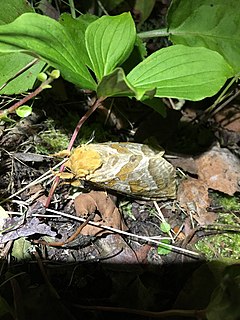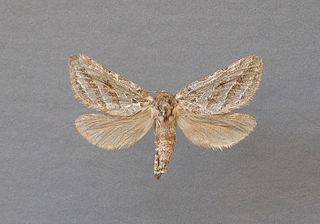Related Research Articles

The Hepialidae are a family of insects in the lepidopteran order. Moths of this family are often referred to as swift moths or ghost moths.

Phymatopus is a genus of moths of the family Hepialidae, which consists of around 500 species and 30 genera. The genus was erected by Hans Daniel Johan Wallengren in 1869. They can be found across Eurasia and North America. Species can be distinguished by the different morphology of male genitalia and different forewing patterns, which vary in stripe colour and size and arrangement of spots. The stripes themselves consist of spots separated by dark veins which are fringed by thin black lines from both inner and outer sides.

Triodia is a genus of moths of the family Hepialidae. There are seven described species found in northern and western Eurasia.

Zenophassus is a monotypic moth genus of the family Hepialidae. The only described species is Z. schamyl of Georgia. The larva of this species feeds on grapevines.

The orange swift or orange moth is a moth belonging to the family Hepialidae. The species was first described by Carl Linnaeus in 1761 and was previously placed in the genus Hepialus. It is distributed throughout Europe.

Abantiades latipennis, known as the Pindi moth, is a species of moth in the family Hepialidae. It may also be referred to as a swift moth or a ghost moth, as this is a common name associated with Hepialidae. Endemic to Australia and identified in 1932, it is most populous in temperate rainforest where eucalypti are prevalent, as the larvae feed primarily on the roots of these trees. Females lay eggs during flight in a scattering fashion. The larvae live for over eighteen months underground, while adult moths survive for approximately one week, as they have no mouthparts with which to feed. The moths are preyed upon by a number of predators, including bats and owls. Brown in colour overall, males are paler and the identifying silver bars of the male's wings are more prominent than those of the female's, with dark margins. Male adults are generally smaller.
Sympistis strioligera is a moth of the family Noctuidae first described by Julius Lederer in 1853. It is found from Asia Minor throughout Iran and Afghanistan and Turkestan to the Altai Mountains, Mongolia and inner Asia.
Endoclita excrescens is a species of moth of the family Hepialidae. It is known from Japan and the Russian Far East. Food plants for this species include Castanea, Nicotiana, Paulownia, Quercus, and Raphanus. The species is considered a pest of the tobacco plant.

Sthenopis pretiosus, the gold-spotted ghost moth, is a species of moth of the family Hepialidae. It was first described by Gottlieb August Wilhelm Herrich-Schäffer in 1856. It can be found in found Brazil, Venezuela and in the eastern United States and south-eastern Canada.

Sthenopis purpurascens, the four-spotted ghost moth, is a species of moth of the family Hepialidae. It was described by Packard in 1863. It is found in Canada and the United States, from Labrador and New York north and west to British Columbia and the Northwest Territories, south in the mountains to Arizona.

Triodia adriaticus is a species of moth belonging to the family Hepialidae. It was described by Osthelder in 1931, and is known from Slovenia, Croatia, North Macedonia and Greece.

Triodia amasinus is a species of moth belonging to the family Hepialidae. It was described by Gottlieb August Wilhelm Herrich-Schäffer in 1851, and it is known from Turkey, Hungary, Romania, Bulgaria, the Republic of Macedonia, Albania and Greece.
Triodia froitzheimi is a species of moth belonging to the family Hepialidae. It was described by Franz Daniel in 1967 and is known from Jordan.
Triodia laetus is a species of moth belonging to the family Hepialidae. It was described by Staudinger in 1877, and is known from Central Russia and Armenia.
Triodia mlokossevitschi is a species of moth belonging to the family Hepialidae. It was described by Romanoff in 1884, and is known from Armenia.

Scopula beckeraria is a moth of the family Geometridae. It was described by Julius Lederer in 1853. It is found in Italy, Croatia, North Macedonia, Greece, Bulgaria, Romania, Ukraine, Russia, Turkey, Armenia, Israel, Lebanon, Iran, Turkmenistan and Kazakhstan.

Aemene altaica is a moth of the family Erebidae. It was described by Julius Lederer in 1855. It is found in the Russian Far East, China, Korea and Japan.
References
- ↑ Nielsen, Ebbe S.; Robinson, Gaden S.; Wagner, David L. (2000). "Ghost-moths of the world: a global inventory and bibliography of the Exoporia (Mnesarchaeoidea and Hepialoidea) (Lepidoptera)" (PDF). Journal of Natural History. 34 (6): 823–878. doi:10.1080/002229300299282. S2CID 86004391.